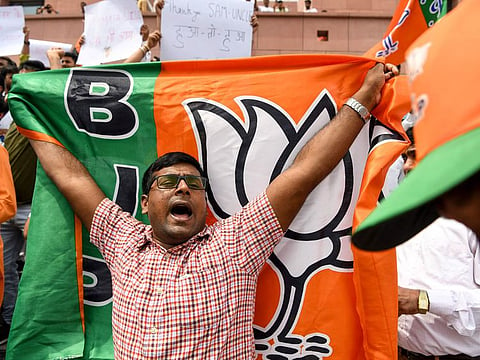India Votes: World’s largest democracy prepares for historic 2024 elections
From Himalayan heights to coastal retreats every vote counts in India’s democratic odyssey

On Saturday, March 16, Rajiv Kumar, India’s Chief Election Commissioner (CEC), made an important announcement. The most populous country and largest democracy in the world would go to the polls in seven phases from April 19 to June 1, 2024. The results would be notified on June 4.
543 seats in the Lok Sabha, India’s lower house, are up for grabs. The party that wins the largest number will be invited to form the government. Just two days earlier, India’s two new Election Commissioners, Gyanesh Kumar and Sukhbir Singh Sandhu, were announced making the complete cohort of three to oversee the largest such exercise in the world.
Consequent upon the announcement, the model code of conduct immediately comes into force. Aimed at both securing the peace and ensuring a level playing field to all parties and candidates, it prevents all participants in what has been described as the world’s largest festival of democracy from indulging in hate speech, abusing each other, provoking religious antagonism, or misusing campaign machinery during electioneering.
Almost a billion people will be eligible to cast their vote — 969 million to be more accurate, of which 19 million will be new voters. Stretching over 44 days, no election in the world has ever been held on this scale in human history.
Across glaciers and deserts
To register each vote cast by adult franchise, over 5.5 million electronic voting machines (EVMs) will be installed in over 1 million polling booths spread across the length and breadth of the country, from the snow-capped Himalayan heights to the deserts of Rajasthan, down to the sparsely populated islands of the Andaman archipelago in the Indian Ocean.
Over 15 million election officials and security personnel will be deployed to conduct this gargantuan exercise. To the exotically inclined, these officials “will trek across glaciers and deserts, ride elephants and camels, and travel by boats and helicopters to ensure every voter can cast their ballot,” as one well-known international news organisation observed. But for most of them, the task will be much more down to earth, with most government schools across the land hosting election booths on counting day.
India has 2,660 registered political parties. Each party contesting in the election is assigned a unique election symbol. But the actual number of parties in the reckoning is much smaller. In the 2019 general elections, there were only seven national and 43 regional parties in the fray, with an additional 623 unrecognised parties also giving it a go. Most of the latter failed to bag a single seat.
How much will the 2024 general elections cost? Government expenses alone are expected to be over Rs. 5000 crores ($600 million). As to what political parties and candidates spend, the sky is the limit. Some estimates put the total figures as high as Rs1.2 trillion ($14.4bn), making it the most expensive election in the world.
The sequence of the voting is as follows: April 19, 102 constituencies; April 26, 89 constituencies; May 7, 94 constituencies; May 13, 96 constituencies; May 20, 49 constituencies; May 25 and June 1, 57 constituencies each. Assembly elections in Andhra Pradesh, Arunachal Pradesh, Odisha, and Sikkim will also be held at the same time.
Also Read: Modi’s southward surge continues unabated
Also Read: India-West bond hits high note in Munich
'There is no alternative'
India, the world’s largest democracy, is renowned for its mammoth electoral processes, often spanning several weeks. The 2024 general elections in India are no exception, given the complexity and scale of the country. With the nation’s vast population and diverse landscape, conducting elections is a monumental task, requiring meticulous planning and execution. The decision to conduct the elections in seven phases reflects the unique challenges faced by the Election Commission of India (ECI) in ensuring free, fair, and accessible elections across the country.
Apart from India’s population density and geographical diversity, security concerns will also dominate the conduct of the elections. In the past, India has faced various security threats, including insurgencies, terrorism, and communal tensions. Ensuring the safety and security of voters, election officials, and polling stations is paramount.
Conducting elections in multiple phases allows for the deployment of security forces in a staggered manner, minimising vulnerabilities and enhancing protection. Over 67% of the electorate cast their votes in 2019. This year, the turnout is expected to be equally high, despite the searing summer months during which the polling will be held.
Now to the most important question: who will emerge the victor in these elections? The ruling Bharatiya Janata Party (BJP) led by its popular prime minister, Narendra Modi, is widely expected to win again, that too with increased vote percentages and margins. In the last general elections, held in 2019, the BJP won 303 seats on its own. The National Democratic Alliance (NDA), which it heads, bagged 353. This time Modi has set a target of over 375 seats for the BJP and 400 for the NDA.
The opposition I.N. D. I. alliance is in disarray, with its principal party, the Congress, feared to fare even worse than in 2019, when it could only manage a meagre 52 seats.
Modi has never lost an election in his life. If he and his party win again, he will embark upon an unprecedented third term as India’s head of government. His great asset is his enduring appeal to aspirational India.
The “Modi guarantee” is to make India great once again. But perhaps an even greater asset is captured in the acronym “TINA” — there is no alternative. Too true.
Sign up for the Daily Briefing
Get the latest news and updates straight to your inbox




